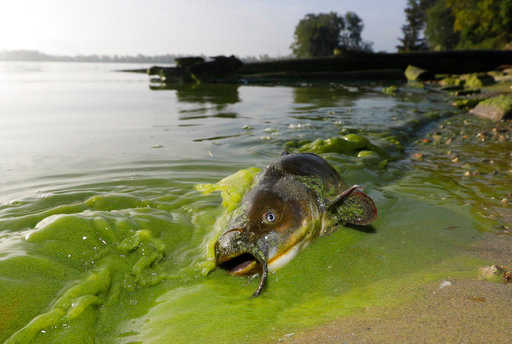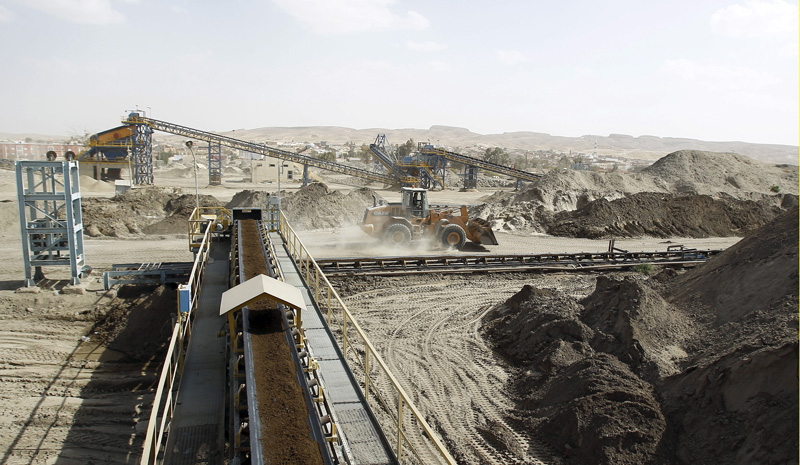The past century was the century of oil, and this is the century of water. The next one will be the century of phosphate.
Billions of years ago, nature bet the biological house on phosphate, a simple pyramid-shaped molecule with four oxygens at its base and a phosphorus atom at the peak. Phosphate is a building block of adenosine triphosphate (ATP), which serves a crucial role storing and transferring energy in the cells of all living things. In plants specifically, ATP is part of the photosynthesis process, and the ability to make plants grow big and strong with the application of essential nutrients like phosphorus through chemical fertilizers has been the foundation of our modern food system for almost a century.
There is only a small amount of concentrated phosphate on this planet, and we are consuming it at an unsustainable rate to grow food for 7.7 billion people.
Here is where the house may soon have to fold: There is only a small amount of concentrated phosphate on this planet, and we are consuming it at an unsustainable rate to grow food for 7.7 billion people.
When will we run out of phosphate? Some estimates place our demand curve exceeding supply within this century; others are slightly more optimistic, though not by much [Cordell et al., 2009; Filippelli, 2018; Nedelciu et al., 2020]. But the reality is simple—very little concentrated phosphate is within reach on the planet, and all of it is in rock. Since the reliance on chemical fertilization started in the middle of the past century, we have blown through roughly 30%–50% of our total economic reserves.
Although phosphate is a critically valuable resource for food production, it is, at the same time, a crippling pollutant in the environment—phosphorus and nitrogen runoff regularly overfertilize aquatic plants, bacteria, and algae. Our collective human activities have already roughly doubled the amount of phosphate in the world’s rivers, hence the expansive eutrophication leading to the Gulf of Mexico dead zone and the explosion of harmful algal blooms [Elser and Haygarth, 2020]. Reducing this massive amount of phosphate waste—not only to protect the environment but also because we crucially need to conserve our supply—requires a focus on rethinking global food systems so that leakage from farm fields and from chemical-grain-livestock-human transmission losses is shored up.
Unlike fossil fuels, another nonrenewable resource that we are at least attempting to reduce our reliance on with alternate sources of energy, phosphate currently has no substitute. With very few U.S. policies in place, and even fewer around the world, to curb phosphate use, reclaim what’s being wasted, or invest in safe and equitable ways to mine for more, little is being done to change the dire phosphate forecast and chart a sustainable and just food future.
Three Recommendations for Phosphate…for Now
The phosphate supply-demand curve intersection is still decades or even a century away, and phosphate rock prices are still relatively low. Now is our opportunity to make significant changes in the global phosphate cycle: use less, recycle better, and find more.
Action 1: Use less but integrate equity. Phosphate fertilization use has already gone down somewhat in the developed world. For decades in the United States and other western countries, crop scientists have been trying to figure out where that sweet spot is between a cornstalk having enough phosphate during its 6–8 weeks of plant growth but not so much that it washes off the field in a spring rainstorm. Because residual phosphate stays in the soil, it provides a partial benefit to next year’s crop—as a result, some overfertilization has benefited Western growers. However, agricultural systems in Africa, South America, and many parts of Asia have historically been underfertilized, and as we try to address chronic hunger in those regions, crops are likely to need more fertilizer. These are global food justice issues that need to be part of any conversation to reduce phosphate use.

Overfertilization is also an immediate concern for environmental health, as that small portion of phosphate that washes off a field is joined downstream by all of the other small portions to become a serious water eutrophication issue. Harmful algal blooms fueled by fertilizer runoff and climate change have become a direct threat to human health as well—in 2014 the entire city of Toledo, Ohio, had to shut off its water taps for days because its only supply, from Lake Erie, was contaminated by neurotoxic algae.
Overfertilization is an easy target, but more difficult is shifting the food system itself, which relies on a phosphate-inefficient loop of growing grain for animal feed, sugar, and oil before a single human is fed. We don’t know yet how far we can stretch food production without chemical fertilizers or what that will look like in terms of the supportable population, lifestyle, and equity. Before we’re forced to find out, we need to transition away from annual grain crops to perennial grain, less grain, and grain for human food. Standing in the way of this transition are global corporate fertilizer-seed-livestock conglomerates, government policies and regulations, and global food access. An individual becoming vegan is not going to solve the impending phosphate crisis, but a rethinking of systems could, much as climate change cannot be solved by individual action alone but, rather, requires systemic changes.
Action 2: Innovate and invest in better recycling. As animals, we consume plenty of phosphate-containing foods. Our biological phosphate needs are modest—mostly to support skeletal growth. Most of the phosphate that we consume is excreted and, like all of the other stuff that is flushed down the toilet, transported to wastewater treatment plants. There, most of that phosphate-containing organic sludge is treated and sterilized and then added to landfill or reused as biosolid composts. But it is not recycled for use in chemical fertilizers. In addition, inadvertent phosphate mineralization, called struvite, often clogs wastewater pipes and is removed and discarded.
Let’s invest in methods of recycling this massive amount of phosphate waste. It is estimated that up to 70% of the otherwise “lost phosphate” from wastewater systems could be recovered through a host of struvite-based phosphate capture systems [Le Corre et al., 2009]. Some municipalities are installing these systems into their wastewater treatment plants. Ideas for livestock waste include portable trailer-based units that can go farm to farm, with liquid livestock manure pumped in one side and mineral struvite percolating to the bottom as a phosphate-rich sediment.
Action 3: Get policies in place so we can find more. The first two approaches—use less and recycle better—are important, but they are not enough to bring us to net zero phosphorus consumption. Global population and development, grain production, and meat consumption are all increasing. To forestall the inevitable phosphate crash, serious attention needs to be paid to increasing our available supply through mining.

Many of the phosphate-rich areas around the world have already been exploited, and many others, for example, two mammoth phosphate-rich geologic deposits in the United States, are too difficult to access [Filippelli, 2011]. The Permian Phosphoria Formation in Wyoming, Utah, and Idaho is complex and folded, and the more phosphate-rich intervals are not only high in toxic metals that would need to be attended to upon processing but also intermixed with phosphate-free units. The Miocene Monterey Formation along the California coast, in contrast, has several very concentrated high-value layers, but much is under the Pacific Ocean or under coastal mansions.
We need to more fully explore the science of—as well as the science policy needed for—dredging offshore phosphates as a way to increase our supply. Offshore deposits have been identified in a number of areas, including the Chatham Rise in New Zealand and the continental shelves of Mexico, Namibia, and Peru. Many of these deposits are of high-grade phosphate, concentrated by ocean currents and in sand or silt in nodules or pellet forms, potentially allowing straightforward dredge mining.
On the basis of cores from two phosphate-rich areas of the Namibian shelf and extrapolations of thickness and area of deposits, the total phosphate in this location represents an extraordinary 9% of the estimated global phosphate—one could conservatively estimate that total global seabed deposits add up to 5–10 times this amount, meaning that seabed phosphates could increase the resource pool by 50%–100% [Compton and Bergh, 2016]. On this promise, the Namibian government issued several dredge-mining licenses, but subsequent concerns about how activities might affect fisheries have spurred a moratorium on mining phosphates pending further research.
We need to develop good policies now that limit environmental impacts, particularly in lower-income countries without adequate tools to conduct environmental assessments and operations inspections.
Indeed, the proposed dredging operations might have long-term economic and ecosystem implications. Most offshore phosphate resources are near active fisheries—this is not a coincidence, as the phosphate-fueled algal production currently fuels high-yield coastal fisheries. Thus, any mining activities, including removing that phosphate, might also negatively affect valuable fisheries resources. Phosphate deposits also typically contain high concentrations of potentially toxic trace metals. Although the ore processing would be done on land, there is a potential for the release of toxic trace metals into the ocean from the mining activity itself [Gnandi and Tobschall, 1999].
Currently, there is very little science exploring practices that reduce collateral damage from dredging operations, selective targeting and spacing of operations to reduce negative impacts, and recovery times for offshore ecosystems. The state of research is so poor that any current mining operations seem ill-advised. Even so, diamond companies are already dredge mining off the Namibian coast, and phosphate-dredging licenses are a nod away from being released. We need to develop good policies now that limit environmental impacts, particularly in lower-income countries without adequate tools to conduct environmental assessments and operations inspections.
We Cannot Fold
The more existential question is, What will we do when we have clawed out the last kilogram of phosphate rock from Earth? The reality is that at some time in the foreseeable future we will not have enough phosphate to grow enough food to feed 7.7 billion, or 10 billion, people, certainly not using food systems that we have today. We have the opportunity now to see the phosphate hand before it’s dealt to us. Let’s act now to save the house.
References
Compton, J. S., and E. W. Bergh (2016), Phosphorite deposits on the Namibian shelf, Mar. Geol., 380, 290–314, https://doi.org/10.1016/j.margeo.2016.04.006.
Cordell, D., J.-O. Drangert, and S. White (2009), The story of phosphorus: Global food security and food for thought, Global Environ. Change, 19, 292–305, https://doi.org/10.1016/j.gloenvcha.2008.10.009.
Elser, J., and P. Haygarth (2020), Phosphorus: Past and Future, 248 pp., Oxford Univ. Press, Oxford, U.K.
Filippelli, G. M. (2011), Phosphate rock formation and marine phosphorus geochemistry: The deep time perspective, Chemosphere, 84, 759–766, https://doi.org/10.1016/j.chemosphere.2011.02.019.
Filippelli, G. M. (2018), Exploring the paradox of increased global health and degraded global environment: How much borrowed time is humanity living on?, GeoHealth, 2, 226–228, https://doi.org/10.1029/2018GH000155.
Gnandi, K., and H. J. Tobschall (1999), The pollution of marine sediments by trace elements in the coastal region of Togo caused by dumping of cadmium-rich phosphorite tailing into the sea, Environ. Geol., 38(1), 13–24, https://doi.org/10.1007/s002540050396.
Le Corre, K. S., et al. (2009), Phosphorus recovery from wastewater by struvite crystallization: A review, Crit. Rev. Environ. Sci. Technol., 39(6), 433–477, https://doi.org/10.1080/10643380701640573.
Nedelciu, C. E., et al. (2020), Global phosphorus supply chain dynamics: Assessing regional impact to 2020, Global Food Secur., 26, 100426, https://doi.org/10.1016/j.gfs.2020.100426.
Author Information
Gabriel Filippelli ([email protected]), Center for Urban Health, Indiana University–Purdue University Indianapolis; Editor in Chief, GeoHealth
Citation:
Filippelli, G. (2021), Our losing phosphate wager, Eos, 102, https://doi.org/10.1029/2021EO157561. Published on 22 April 2021.
Text © 2021. The authors. CC BY-NC-ND 3.0
Except where otherwise noted, images are subject to copyright. Any reuse without express permission from the copyright owner is prohibited.

